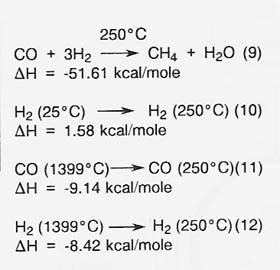
Reduction of Carbon Monoxide
The estimates of heat and power requirements are based on the following changes:

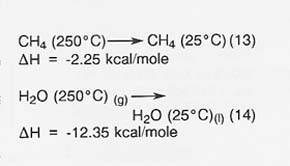
The process flowsheet for this section is shown in figure 15. The operating temperature of 250�C is used as a conservative value. Operating at higher temperature offers a modest advantage in reducing radiator weight.
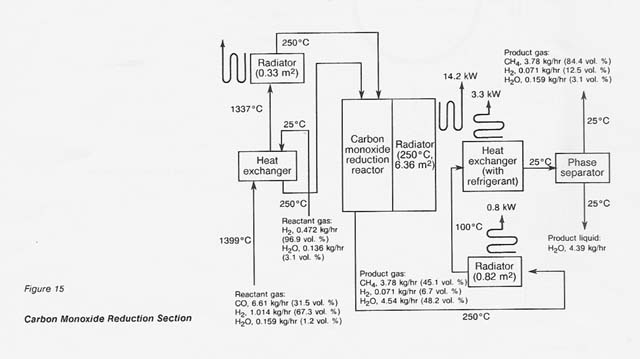
Water Electrolysis
Most of the weight of the electrolysis unit is that of the refrigeration cooling system and radiators used to reject low- temperature heat. The details of this section are shown in figure 16. A high-pressure electrolysis unit will allow operation at higher temperatures and higher efficiencies--a situation advantageous for both weight and power savings. However, the high-pressure electrolysis unit itself is heavier than a low- pressure unit and, because of added corrosion problems, requires considerably more maintenance. Consequently, detailed tradeoff analysis of low- pressure versus high-pressure electrolysis is needed.
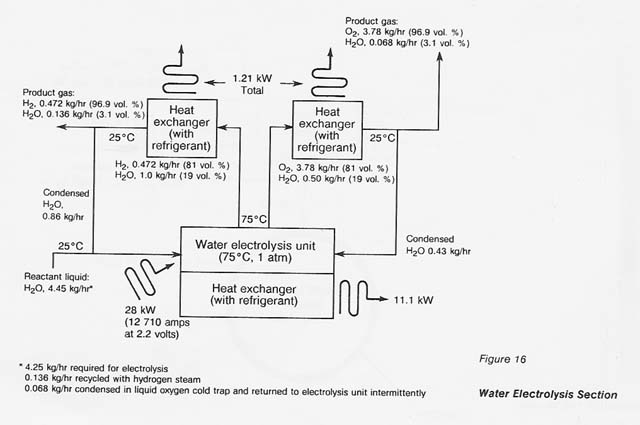
Oxygen Liquefaction
The oxygen liquefaction system is composed of Norelco type 12080 gas liquefiers. These units use helium as a refrigerant; some makeup helium is required. The details of this section are shown in figure 17. The amount of helium indicated in the tables is for a 1-year operation.
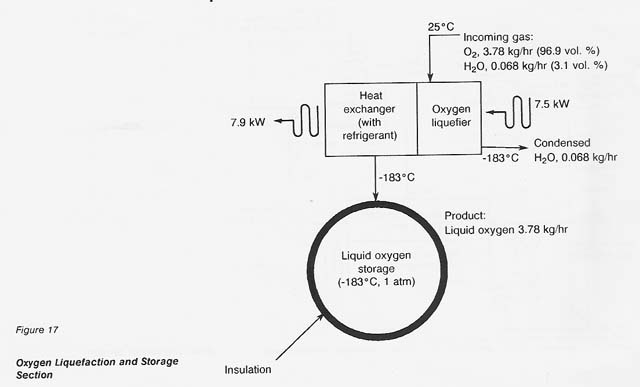
Oxygen Storage
The oxygen storage system consists of spheres of aluminum with walls 1.02 cm thick and an outer diameter of 3.20 m. Each sphere is capable of containing a 6-month supply of oxygen when it is produced at a rate of 2721 kg/month. These spheres are insulated to reduce boiloff. Boiloff oxygen is recondensed and returned to storage. The utilization of empty oxidizer storage tanks on lunar landing vehicles may eliminate the need for these storage spheres. Figure 17 summarizes the details of this section.
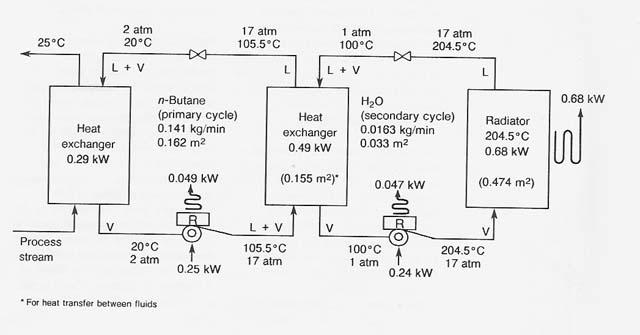
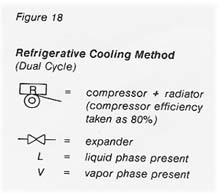
In the estimates for the different sections of the process, power requirements are given for these two different methods of cooling. In the following tables and figures, method 1 indicates the refrigerative technique and method 2 indicates the radiative technique. The details of the two methods are discussed later in this paper.
Refrigeration and Heat Radiation
The flowsheet for the refrigeration system used for method 1 cooling is shown in figure 18. The numerical values given are for a heat rejection rate of 0.29 kW. These values may be multiplied by the factor 0/0.29 to obtain correct values for any desired heat rejection rate of 0 (kW).
The liquid n-butane absorbs the heat at 20°C (2 atm), vaporizes, and is compressed to 17 atm (105.5°C). The stream gives up its latent heat to liquid water at 100 ° C (1 atm) and condenses at 105.5°C (17 atm). Upon flowing through the expander, the n-butane partially evaporates until its temperature and pressure are lowered to 20°C (2 atm). It is then returned to the heat exchanger where the cycle is repeated.
The water cycle operates similarly but condenses within the radiator at 204.5°C (17 atm) before it is recycled. The radiator operates continuously at this temperature. We assumed that the radiators would be stationary and lie parallel to the lunar surface, exposed to the full radiation of the overhead Sun (lunar midday)-an extremely conservative assumption.
The radiator material is assumed to have an absorptil:/ity of 0.35 and an emissivity of 0.77. The heat rejection rates for this type of radiator are taken from" Lunar Logistic System" (MSFC 1963). The reported values are based on an estimated 80-percent efficiency. The radiator mass factors used in our estimates were 6.1 kg/m^2 surface area for a plain radiator, and 19.5 kg/m^2 surface area for a radiator with refrigeration. This latter value was also used for systems in which fluids condense or cool in tubes within or attached to the radiator. The 19.5 mass factor was obtained from" Lunar Logistic System" (MSFC 1963).
Compressor efficiencies are taken as 80 percent. The extra power required is rejected as heat from radiators attached to the compressors. Weights of standard compressor and motor units selected for use here were reduced by assuming that nonelectrical parts could be fabricated from lightweight aluminum alloys.
Refrigeration is not needed in method 2. The assumption is made that the radiator sees ~0 K space, either by being perpetually shadowed (for example, when located in depressions near the poles) or by being movable so as to present only an edge to the direct rays of the Sun. An iron-clad aluminum radiator would provide an emissivity of about 0.5 in a lightweight body. Reflectors on its underside and edge would prevent pickup of most of the radiation from the Moon's surface and from the Sun. The mass factor is taken as 9.8 kg/m^2 of surface. Once again, an 80-percent efficiency factor was used.
|
Curator: Al Globus If you find any errors on this page contact Al Globus. |
 |
This site was hosted by the NASA Ames Research Center from 1994-2018 and is now hosted by:
